Flame Guitars V Style Guitar
In 2019 I was approached by Ian Dow about the possibility of making a copy of a guitar made for Albert King in the early 70’s by Dan Erlewine. The distinctive feature of this guitar is that it has Albert King’s name inlaid in the fretboard and “Lucy” inlaid in the headstock.
In the end, Ian and I agreed that I would not make a direct copy of the Albert King guitar, but the final specification for Ian’s guitar is certainly influenced by the King guitar.
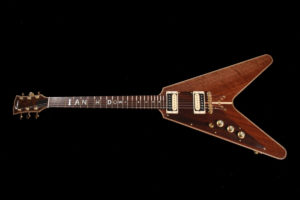
Specification for the guitar
- Black walnut body and neck
- Burl walnut headstock
- Rosewood fretboard
- Rosewood pickguard
- Chambered body
- Bound body and headstock
- Maple stripe running through the body and neck
- Tone Pro bridge
- Grover locking tuners
- Dimarzio 36th Anniversary pickups
- Evo gold fretwire
- Mother of pearl inlays in fretboard and headstock
- Gloss lacquer finish
Fretboard and headstock inlays
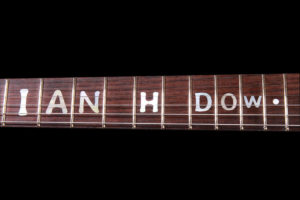
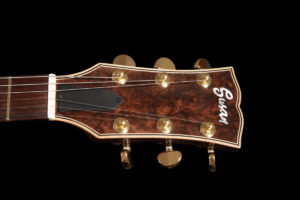
A number of different options for the style of letters used for the inlays was discussed. Once the final font styles were agreed there was still quite a lot of setting out to do on my part. As you can see, each letter of Ian’s name has to be of a slightly different width and height in order for the letters to sit correctly between the frets.
Each letter for the fretboard inlay had to be hand cut out of 2mm thick mother of pearl. A dremmel tool was then used to route out the fretboard. Rosewood is quite an unforgiving material when it comes to inlay work. Small gaps can not really be filled in the way that it is possible to do with ebony fretboards. So I had to work slowly and take frequent breaks to keep my concentration. The last thing I would want to do is make a stupid mistake when inserting the last letter!
The headstock inlay was more of a challenge. The font chosen for “Susan” was quite difficult to replicate in mother of pearl. Again, a lot of patience was needed when cutting out the name and setting it in the burl walnut headstock. Any mistakes would be difficult to rectify.
In the end I was very pleased with how it looked. No gap filling paste was used!
Maple binding for the body and headstock
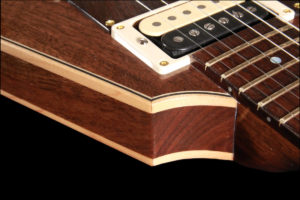
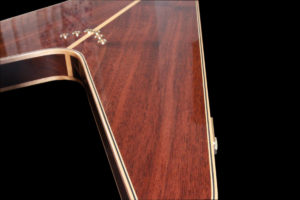
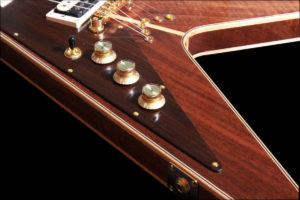
A maple strip runs through the body and neck. So I decided to use maple for the bindings rather than plastic. Although I have done body binding in wood many times before, because of the amount of binding needed and due to the tight curves at the end of each wing, binding this guitar proved to be more difficult and time consuming than I anticipated. Each strip of maple has to be bent to the right shape. And if there are gaps where the binding meets the body it can look awful.
Still, it was my choice to bind with maple and not plastic. I think it does work extremely well with the central maple strip. But would I do this again? I’m not sure.
Conclusion of the project
So importantly, how did the guitar play and how did it sound? With a one-off build like this you never know quite how the instrument will sound.
The first thing that struck me when I put on the first set of strings was how “alive” the guitar felt. It had wonderful sustain, and when plugged in for the first time I was surprised by how the chords just rang out. It is a chambered guitar and I’m sure this helps with the sustain. The Dimarzio pickups work really well with this guitar. Just lovely on a clean setting.
Despite some of the challenges I really enjoyed this build. And I am grateful to Ian for having the confidence in me to bring his dream into reality. Here is an email he sent me some days after collecting his new guitar:
“Hi David, I just wanted to say thank you for all your hard work in building this guitar for me, the result is all that I was hoping for and I just cannot put her down. Once again… thank you”
Video about the building of this guitar
If you would like to watch a video I made about the building of this guitar please click on this LINK. Toward the end of the video you can hear the guitar being played by Phil Short. Phil kindly agreed to demo the guitar when he came to pick up one of his guitars.
